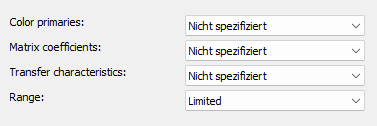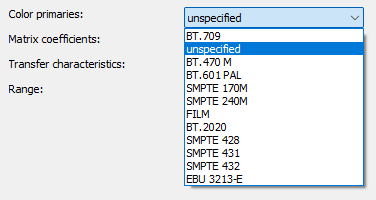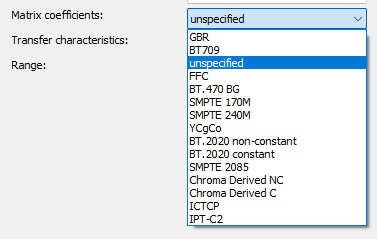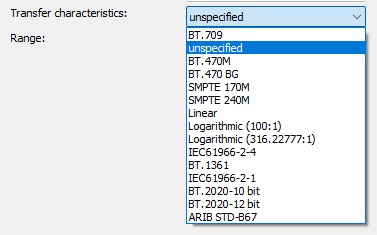AV1 Codec - Video Usability Information (VUI)
When editing or exporting video and image material, precise color space and range settings are crucial to ensure correct display on different devices.
Depending on the output device – such as a television, computer, or streaming platform – color and brightness settings must be defined, as they determine how colors and contrasts are reproduced.
The information is stored as additional metadata and helps the decoder or playback device to display a video correctly.

Advertisement
Color primaries
Specifies which color space is used (i.e. how "red", "green" and "blue" are defined)

Recommended settings:
- BT.709 for HD-Videos (z.B. 1080p)
- BT.2020 for 4K/UHD-Videos
| Name | Purpose / Application |
| Unspecified | No concrete color space definition is given. Playback devices must guess or make a default assumption (often BT.709). |
| BT.709 | Standard for HDTV (1920×1080) and modern online videos. Widely used on YouTube, Blu-ray and TV productions. |
| BT.470 M | Old standard for analog NTSC television systems (mainly USA/Japan). Rarely used today. |
| BT.601 PAL | Standard for SD (Standard Definition) video in the PAL system (Europe, Australia, parts of Asia). |
| SMPTE 170M | Similar to BT.601, but adapted for modern digital NTSC SD formats Used mainly with old US and Japanese SD content. |
| SMPTE 240M | Earlier HDTV specification (before BT.709). Outdated and rarely used. |
| FILM | Color primary data corresponding to classic cinema films. Not standardized for digital formats; rarely used. |
| BT.2020 | Color space for UHD and 4K/8K (Ultra High Definition) videos. Significantly wider color space than BT.709. Required for HDR (High Dynamic Range) content. |
| SMPTE 428 | Digital cinema standard (DCI, Digital Cinema Initiatives). Used in cinemas for 2K and 4K projection. |
| SMPTE 431 | Defines specific color primary data for digital cinema, especially for certain color representations. |
| SMPTE 432 | Extension of SMPTE 431, supports wider color gamuts for cinema applications. |
| EBU 3213-E | European standard for studio productions, especially for SDTV (PAL/SECAM). |
Matrix coefficients
Determines how the image is internally converted between brightness (Y) and colors (Cb/Cr).

Recommended settings:
- BT.709 for HD-Videos (z.B. 1080p)
- BT.2020 non-constant for UHD-Videos
| Name | Purpose / Application |
| unspecified | No concrete color space definition is given. Playback devices must guess or make a default assumption. |
| GBR | No YUV – pure RGB (e.g. for graphics or uncompressed video). |
| BT709 | HD videos (720p, 1080p). Widely used. |
| FCC | FCC Title 47 CFR §73.682 (a)(20) – Color space matrix for NTSC TV (USA), slightly different from BT.601. Obsolete, but still used in some older NTSC systems. |
| BT.470 BG | SD standard for PAL/SECAM (Europe, Asia). Complies with BT.601. |
| SMPTE 170M | SD standard for NTSC (USA, Japan). |
| SMPTE 240M | Outdated, previously used for HD. |
| YCgCo | Alternative color space, efficient for compression. |
| BT.2020 non-constant | For UHD/HDR, non-constant luminance ratio (less common). |
| BT.2020 constant | Standard for UHD/HDR. Constant luma weighting. |
| SMPTE 2085 | For High Dynamic Range (HDR), often combined with PQ curve. |
| Chroma Derived NC | Chroma is derived from RGB and is not constant. The exact mode depends on the encoder. |
| Chroma Derived C | Chroma derived from RGB, constant. |
| ICTCP | Modern HDR color system, recommended with PQ transfer curve (SMPTE ST 2094). |
| IPT-C2 | Alternative HDR display, mostly experimental. |
Transfer characteristics
Determines how the brightness is implemented in the image (gamma curve)

Recommended settings:
- BT.709 for HD-Videos (z.B. 1080p)
- BT.2020 (10-bit) for HDR content
Range
Determines how large the value range of brightness and colors is

Recommended settings:
- Limited (16–235) for videos to be played on TVs
- Full (0–255) for PC displays, web videos or gaming
